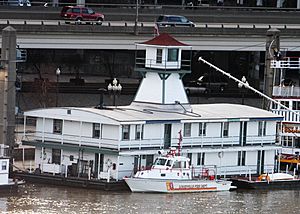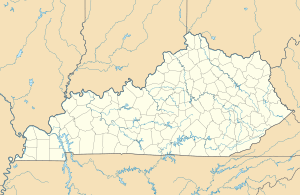Mayor Andrew Broaddus facts for kids

Mayor Andrew Broaddus, a two story structure with elevated lookout tower
|
|
Quick facts for kids History |
|
|---|---|
| Name | Mayor Andrew Broaddus |
| Launched | 1929 |
| General characteristics | |
| Length | 98 ft (30 m) |
| Beam | 38 ft (12 m) |
| Depth | 5 ft (1.5 m) |
|
Mayor Andrew Broaddus
|
|
| Location | Louisville, Kentucky |
| Built | 1928 |
| NRHP reference No. | 89001446 |
| Significant dates | |
| Added to NRHP | 30 June 1989 |
| Designated NHL | 30 June 1989 |
The Mayor Andrew Broaddus is a special kind of boat called a lifesaving station. It was built to help people in trouble on the water. This station is located in Louisville, Kentucky. It was named after Andrew Broaddus (1900-1972), who used to be the mayor of Louisville.
The main job of the Mayor Andrew Broaddus was to protect travelers on the Ohio River. It helped people near the Falls of the Ohio, which is a dangerous area with fast-moving water. Rescue teams were ready to help anyone who got into trouble in the rapids. Louisville was the first city in the western United States to have a lifesaving station. The first station in Louisville opened in 1881, and the Mayor Andrew Broaddus was the third one built there. Today, it is a National Historic Landmark. It is the only floating lifesaving station from the US Life-Saving Service that is still around.
Contents
Early Lifesaving Stations
On October 22, 1881, the first lifesaving station, called Life Saving Station #10, started its work at the Falls of the Ohio in Louisville. This spot was known as the most dangerous place on the entire Ohio River. Skilled rivermen, who had volunteered their time before, became part of the Life-Saving Service crew.
This first station boat was built at the Howard Shipyards in Jeffersonville, Indiana. It was the very first lifesaving boat on America's Western Rivers. This wooden boat served until 1902, when a new wooden boat replaced it. Then, in 1929, the Mayor Andrew Broaddus took its place. This new boat had a strong steel hull and a unique watchtower.
Helping During Important Times
Besides its main job of rescuing river travelers, Life Saving Station #10 also played a role during World War II. During this time, Coast Guard Reservists used the station to patrol the river. They watched out for any possible acts of sabotage.
Earlier, the station's crew also helped enforce a time called Prohibition. This was when certain alcoholic drinks were not allowed. The crew would take federal agents to small islands on the Ohio River to look for illegal alcohol operations.
Saving Lives and Property
From 1881 to 1972, the United States Life-Saving Service and later the Coast Guard patrolled the Falls area. They rescued rivermen and passengers and saved boats and their cargo that were stuck. They also recovered people who had drowned and performed heroic actions during big floods on the Ohio River. Records show that between 1881 and 1915, the crews of Life Saving Station #10 saved about 7,000 lives. They also saved property worth about $6 million.
About the Mayor Andrew Broaddus
The Mayor Andrew Broaddus was built in 1929 in Dubuque, Iowa. It has a strong steel hull. The boat is about 98 feet (30 m) long and 38 feet (12 m) wide. Its hold, which is the space inside the hull, is 5 feet (1.5 m) deep. The boat has two decks and a tall, 15-foot-tall (4.6 m) lookout tower. Much of its original inside parts are still there, and the boat is in good condition.
The Mayor Andrew Broaddus is special because it is the only floating lifesaving station left. It is also the last inland waterway lifesaving station for the United States Coast Guard that still exists. It helps us remember that the U.S. Life-Saving Service once existed.
Current Use and Repairs
Today, the Mayor Andrew Broaddus helps out the Belle of Louisville, which is another famous historic boat. The Mayor Andrew Broaddus provides office space for the Belle of Louisville crew.
In the spring of 2007, the hull of the Mayor Andrew Broaddus was damaged by another ship. In November of that year, it was taken to Jeffboat for repairs. There were plans in 2007 to create a museum inside the boat in the future.


